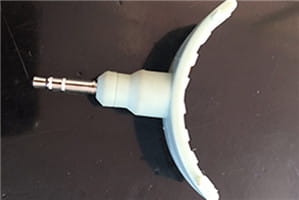Liquid silicone coating
13 Nov 2019
LSR process is generally adopted for injection bonding of liquid silicone coating. The hard plastic parts that have been injected with beer (injection molding) are fixed on the plastic coating mold, and then the liquid silicone injection is pasted to the hard plastic parts at an appropriate temperature, and the products are obtained by heating the mold.
Due to the temperature to allow the substrate and liquid silicone two materials suitable.
The plastic base material usually chosen is PC or PA.
1. Lack of glue -- the product is trapped or the injection amount is not enough.
2. Split seam and overflow edge -- increase clamping force;
Reduce injection pressures.
3. Product injection molding deformation -- reduce molding temperature;
Select high temperature resistant substrate.
4, poor viscosity -- whether the plastic substrate is clean and dry, choose the appropriate liquid silicone adhesive.
Above point 4 viscosity differences are the most encountered problem.
How to solve it?
Say that this is a 3C product.
Through LSR process, the liquid silicone injection molding is bonded to nylon PA.

PA6 and PA66 are semi-crystalline strong polar plastic.
In addition, PA6 and PA66 are not difficult to absorb water, which are unfavorable factors for cladding adhesion.
Therefore, after cleaning nylon before bonding, be sure to dry it, otherwise it will lead to poor adhesion or blistering of the LSR process.
Choose the appropriate adhesive, cornelian cl-24s-15 liquid silicone wrapped nylon glue, adhesive film, stable, LSR production process do not worry.
Compare samples are fast and can be customized.
The principal industries of LSR are silicone tableware, infant products, smart wear, 3C and other products.
Such products need to be environmentally friendly and non-toxic.
Anglican liquid silicone adhesives have passed SGS certification.
KANGLIBANG is to creat solution for your problem with bonding silicone, welcome customer inquiry to us.






